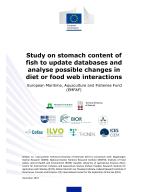Details
- Identification
- ISBN 978-92-9405-032-8, PDF HZ-05-24-039-EN-N, DOI 10.2926/683598
- Publication date
- 17 January 2024
- Author
- European Climate, Infrastructure and Environment Executive Agency
Description
Fish stomach content is a compelling data source, as stomachs can provide information about diet of predators, distribution of prey fish, predator-prey preference or changes in diet over time. For instance, stomach samples have historically been used to inform the natural mortality of stock assessments in the Baltic and North Seas. Since stomach samples tend to vary substantially over time, due to differences in biomass of predator and prey, time series must be constructed to provide critical information on food web interactions in time and space. The study aimed (1) to analyse new stomach samples, from the North and Baltic Seas; (2) to continue historical time series; (3) to update and create an online ICES database for the broader community to explore new and old data in conjunction; and (4) to perform preliminary analysis on the newly added data.
In total, 10 087 new stomachs were provided from the two case study areas (Baltic Sea: cod (Gadus morhua) and whiting (Merlangius merlangus); and North Sea: mackerel (Scomber scombrus), whiting (Merlangius merlangus), cod (Gadus morhua), monkfish (Lophius piscatorius), grey gurnard (Eutrigla gurnardus), horse mackerel (Trachurus trachurus) and turbot (Scophthalmus maximus)). Additionally, 27 744 historical stomach data have been uploaded.
The analysis provided here show that the predation on saduria and sprat by cod in the Baltic Sea has changed over the last 30 years. In the North Sea, the new samples consisted primarily of unidentified matter, benthic food and crustaceans, whereas the historical samples contain a larger number of commercial fish.

